Abstract
The purpose of the study is to design a model of integration of visual literacy (VL) teaching into the English for specific purposes (ESP) course at university. The research has focused on the systemic characteristics of the structural components of the integrative model: learning objectives, learning outcomes, content and methodology of a VL-oriented ESP course. Integrative learning objectives of the ESP course are formulated as development of VL and improvement of English communication skills in university students in profession-related contexts. Visual literacy is defined as a combination of cognitive abilities to understand communication of visual messages, express ideas visually and think critically about visual messages. For assessing VL (learning outcomes) in students, the criterion-based scheme has been designed. The ESP course content integrates three basic components: VL-related content, theme-based content and language content. Integrative content instruction has been designed on the basis of several visual education approaches: full-spectrum visual learning, active and performance-based learning, critical thinking and visual mapping approaches. The methodology of the ESP course includes visual-based instructional strategies: “deep viewing” method, “reading circles” strategy, sketchnoting method and visual thinking tools. These strategies engage students in both visual literacy and communication practices in profession-related contexts. Integration of VL teaching into the ESP course brings additional benefits: development of students’ creativity, critical thinking skills and open-mindedness.
Keywords: ESP course, integrative model, visual literacy, visual learning, visual communication, visual thinking
Introduction
The rise in visual communication in everyday life has led to a new understanding of the role of the visual in English teaching practices. Pictures, photos, video and other forms of visuals are no longer a decorative element in the language study but they can serve as meaningful objects for analysis, interpretation and communication in the English classroom (Goldstein, 2016). In order to understand, create and interpret visual images, students need to possess a group of special skills which make a person visually literate. As one of the important competencies in the modern world (Simbirtseva, 2013), visual literacy needs to be developed and assessed as one of the learning outcomes in the English classroom in addition to language skills: reading, writing, speaking and listening. At the same time, visual-based language instruction ensures creative meaningful communicative environment so students could be more engaged in different forms of communication, get more motivated in the classroom and, therefore, make better English language improvement (Suryanto, 2014).
The educational significance of VL has been highlighted by educators. The most important benefits of developing VL have been listed as follows: increase in all kinds of verbal skills, students’ motivation and interest in all subjects, students’ self-expression and their ability to better comprehend the today’s world (Avgerinou & Ericson, 1997).
Much of the research on visual literacy and language learning has focused on identifying and evaluating the efficiency of visual literacy strategies for supporting the improvement of students’ reading, listening, speaking and writing skills (Anderson et al., 2015; Bleed, 2005; Bowen, 2017; Brumberger & Northcut, 2013; Goldstein, 2016). Incorporation of VL elements in English language teaching has been discussed in the work by S. Suryanto (2014). The author has identified factors of successful integration of visual teaching into the English classroom: the space of teaching, display facilities, the students’ role in the learning process, teachers’ visual literacy, and assessment schemes. The importance of the use of visual images in ESP materials is highlighted in the study by Chalikandy (2013). According to the author, visual images in the ESP classroom increase the power of observation and reporting what is observed. Also, the impact of video resources on cognitive capacities (grasping and memorizing skills) and development of vocabulary skills in the ESP class has been explored by Milosevic (2017).
However, there remain several aspects of VL teaching which are relatively little studied. For example, there is the need to carry out a systematic analysis of integrated visual and language education objectives, learning content and methodology. Another important issue for further discussion is concerned with approaches and principles of integration of visual education into the ESP class. Also, there are questions about the concept of visual literacy and the criteria of a visually literate person which need to be solved.
Problem Statement
The aim of the ESP course at university is to equip students with English skills for profession-related situations. Traditionally, at universities the main impact is made on enlarging students’ profession-related vocabulary. Mastering vocabulary is mostly done through reading texts on professional topics followed by vocabulary and grammar activities, which make the learning process routine, uninteresting and sometimes demotivating for both teachers and students. One of the greatest challenges for English teachers is to improve students’ communication skills and raise their learning motivation and interest in the ESP classroom. In our opinion, a possible solution to this problem is integration of visual literacy teaching into the ESP instruction. The problem of our study is concerned with conceptualization and organization of a VL-oriented ESP course at universities for better learning outcomes both in relation to students’ visual literacy and English communication skills.
Research Questions
This study discusses the following research questions:
- What is visual literacy? How can visual literacy be observed and measured in students in the ESP class?
- What visual education approaches can be applied to ESP instruction?
- What are the specific content categories of visual education to be learned in the ESP course?
- What are the specific instructional strategies that will help students to improve their visual literacy and communication skills?
Purpose of the Study
The purpose of our study is to design an integrative model of VL teaching in the ESP course at university. In accordance with the purpose of the study, we set the following tasks:
- to specify the concept of “visual literacy” and design a VL assessment scheme;
- to specify integrated content categories of visual education;
- to discuss pedagogical approaches and principles of visual education to be applied to the ESP instruction;
- to choose effective instructional strategies which promote the development of visual literacy and communication skills in students.
Research Methods
The study is based on the systemic, critical thinking and student-centered approaches. Literature analysis on the issues of visual education, modeling method, conceptual ideas about the content of VL (Seels, 1994), VL Standards for Higher Education developed by the Association of College and Research Libraries (Hattwig et al., 2013) are methodologically important for conceptualization and organization of a VL-oriented ESP course.
Findings
The systemic approach to the design of a VL-oriented ESP course allows us to describe the main elements of the educational process (objectives, content and methodology) with the special emphasis on VL and communication. In general, educationaldescribe what students will know and be able to do by the end of the course. They define learning outcomes and focus . In our study, the integrative objectives of the VL-oriented ESP course are as follows: the development of VL and improvement of English communication skills in university students in profession-related contexts.
Our first research question addresses the concept of VL. The problem of VL has been attracting a lot of interest in educators, since this term was first coined by John Debes in 1968. The systemic review of the VL concept has been undertaken by Avgerinou and Ericson (1997). The authors have attempted to establish a more accepted definition of VL and related notions. Besides the problem of definition of VL, other aspects have been in the focus of scholars’ attention: parameters of VL (Avgerinou & Pettersson, 2011), principles and criteria for VL assessment (Bowen, 2017; Kędra, 2018), practical application of VL theories in the classroom (Brumberger & Northcut, 2013; Hattwig et al., 2013; Suryanto, 2014);
The literature review shows that VL definitions vary from very narrow to very broad explanations of the complexity of this concept with the interchangeable use of terms: ability, skills and competency. In general, VL comprises three main abilities: to read and interpret visual messages, to create visual messages and to evaluate visual messages critically.
Based on Seels’s (1994) conceptual ideas about VL, we propose three-component VL model: visual learning, visual communication and visual thinking (Figure 01).
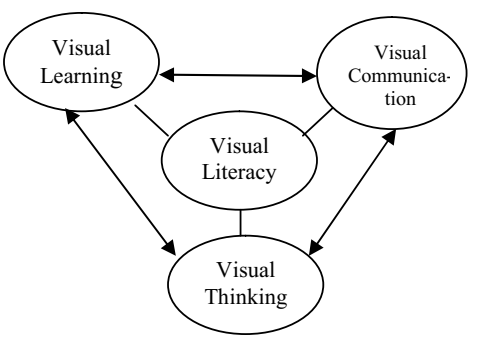
We consider each component of VL as a cognitive ability to do activities specific to visual images. Visual learning is an ability to understand communication of a visual message, to describe its topic and subject matter and to analyze the context. Visual communication is an ability to express ideas visually. This ability is revealed in creating visual messages. Visual thinking is an ability to think critically about the meaning of a visual message and to evaluate the effectiveness of a visual as a means of communication. It is clear, these abilities need to be taught and assessed as learning outcomes together with communication skills in the ESP class.
Educational objectives must be observable and measurable. For assessing the improvement of students’ VL, a curriculum approach can be used. VL abilities are assessed as they are manifested by students in a specific learning context in terms of the quality of a student’s work or a performance of some kind (e.g., a mind map, a PowerPoint presentation, engagement in a guided discussion, etc.). This tradition involves the use of a criterion-related scheme. VL Standards for Higher Education developed by the Association of College and Research Libraries serve as the basis for designing the assessment framework which fixes the progression of VL in students from Level 1 to Levels 2 and 3 (Hattwig, et al., 2013).
The structural analysis of VL and the assessment scheme serve as an instrument to observe and assess VL abilities in students. At the same time, they provide understanding of what to teach and how to teach in the VL-oriented ESP course. So the VL model and VL assessment scheme (Table 1) are used as the basis for course content design and instruction.
The next research question deals with visual education content categories to be integrated into the ESP course. The integration of visual education and language learning brings about such content categories as elements of the visual (shapes, colors, foreground, background, etc.), visual text, visual context and visual subtext (knowledge), visual thinking tools and patterns (strategies), visual learning, visual communication, visual thinking (skills). To sum up, the ESP course content should encompass three basic components: visual-related content, theme-based content and language content. The visual-related content is defined through knowledge, skills and strategies for reading, creating and thinking critically about the visual. The theme-based content is defined through profession-related topics and communicative situations; the language content is defined through grammar and vocabulary, language skills, functions and strategies (Poliakov, 2004).
Further important question of our study is concerned with the organization of instruction of the VL-oriented ESP course. This issue is closely connected with the question of visual education teaching approaches.
- Full-spectrum visual learning. This approach is based on principles of nonlinguistic communication made with visual imagery. Individuals become visually literate by means of practices of visual encoding (expressing thoughts and ideas in a visual form) and visual decoding (translating the content and meaning of a visual imagery) (Gangwer, 2009).
- Active and performance-based learning. This approach helps students to be more involved in the learning process. Real learning occurs when students use their new knowledge or skills in a new context or situation. With this approach, students are constantly challenged to practice visual abilities when they read a visual message, express themselves visually or think critically about the visual to make the meaning of it.
- Critical thinking approach. VL involves cognitive functions such as critical viewing and thinking about the visual (Avgerinou & Pettersson, 2011). Higher order thinking skills are employed in constructing the meaning of the visual, such as analyzing, inferring, evaluating skills, etc. This approach in visually-oriented education nurtures students’ visual thinking abilities, stimulating their interest and participation in the class.
- Visual Mapping approach. This approach involves visualization of ideas in the specially organized way to communicate a message. Both students and teachers can be engaged in visual communication through the use of visual organizers. Teaching content can be effectively planned and presented in any forms of maps. Students, then, can better understand the content, comprehend the relationships between concepts, and memorize the details (Gangwer, 2009; Hartsell, 2015). Students can systemize learning content in the forms of maps, and organize their ideas for further oral practices. This approach also supports oral communication and higher-order thinking in the classroom.
The instruction of the ESP course is organized through the use of specific instructional strategies to teach particular VL abilities and communication skills in students.
Deep viewing method was developed by Ann Watts Pailliotet (1993). This method is used to teach students visual learning and visual thinking abilities in the process of communication about any form of the visual (photo, picture, video, etc.). This method involves three levels: 1. Literal observation; 2. Interpretation; 3. Evaluation. All students form smaller groups to discuss the visual at all three levels step by step. After each level of discussion, groups share their observations with the whole group for a broader picture of understanding the visual. It is useful to assign a coordinator in each small group who will manage the discussion and keep the group focused on the specific task of each level. Also, a list of useful phrases should be prepared by teachers to prompt the discussion. Since Deep Viewing involves listening, speaking, critical thinking and viewing; it offers a way to connect visual literacy and communication practices in the ESP classroom. This method also encourages students’ teamwork, collaborative analysis and acceptance of others' points of view.
“Reading Circles” strategy that is transformed from text-based to visual-based “reading” (Table 2). This strategy mainly addresses visual learning and visual thinking abilities. The students form small groups of 4 people and get role cards with tasks. The roles are as follows: Word Collector (makes up a cloud of words related to all elements of the visual), Narrator (describes what is happening in the visual), Connector (connects the elements of the visual with the meaning of the whole picture), Summarizer (summarizes all the ideas from the group members and writes down the caption to the visual and the message). A “reading circles” strategy includes two stages. On the first stage, students work on their tasks individually; on the second stage, they the visual and share their ideas with each other. Students have a lot of communication practices about the visual, so this strategy promotes visual literacy practice in communicative environment.
Here is an example of students’ role cards for the picture below (under the topic “Companion animals and livestock”) (Figure 02):
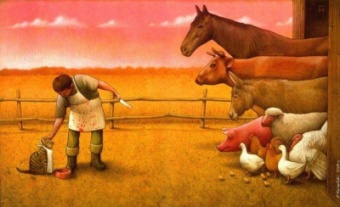
- Sketchnoting method was developed by Mike Rohde (2013). It is useful for improving visual communication and visual thinking abilities in students. In general, sketchnotes are a way to visualize ideas in paper using images and words. Sketchnoting involves 3 steps: 1. Listening/reading/watching for ideas; 2. Analyzing ideas; 3. Mapping ideas. For sketchnoting, students need to learn basic sketchnote patterns (linear, radial, vertical, modular, skyscraper, path, popcorn). Sketchnoting can be used to organize oral speech or to fix main ideas of the written/audio/media text. This method brings real learning benefits: it helps to evaluate ideas and focus on the most important ones to be fixed in the visual way. Besides, it promotes students’ memory skills and concentration: students are better at remembering information after it has been visually fixed. Also, students develop their creativity while sketchnoting.
- Visual thinking tools. These include different types of maps (mind/concept/thinking maps), visual matrixes, collages, and other graphic organizers.
Mind maps are used to organize information visually in the hierarchical order. They show relationships among pieces of information and their relevance to the central idea. Students can organize a large amount of information in an easy-to-read visual form. First, the central idea is defined and placed on a sheet of paper, and then core ideas directly related to the central idea are identified and linked to it as tree branches. The students are encouraged to use different colors, symbols, even simple drawings to represent groups of ideas.
Thinking Maps include eight thinking process maps developed by Dr David Hyerle (2014). They focus on the development of the eight fundamental cognitive processes. They must be introduced to students as tools for organizing information in the visual form. Students can learn to use different maps together and become experienced in choosing which thinking map fits the immediate learning content. These thinking maps can be effectively used in content-specific learning (Figures 3-5).
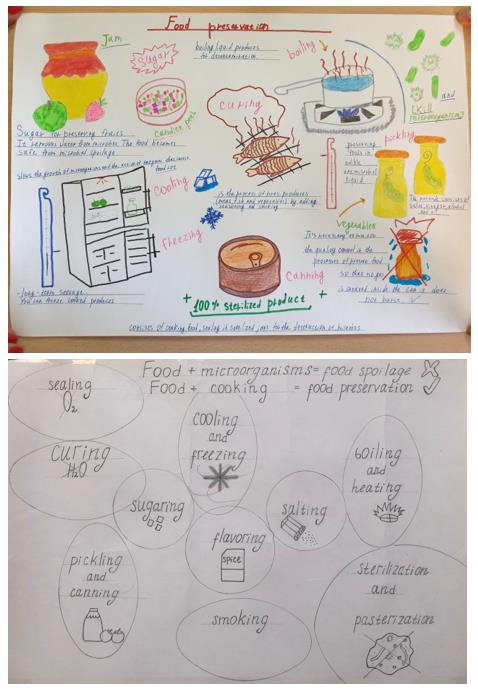
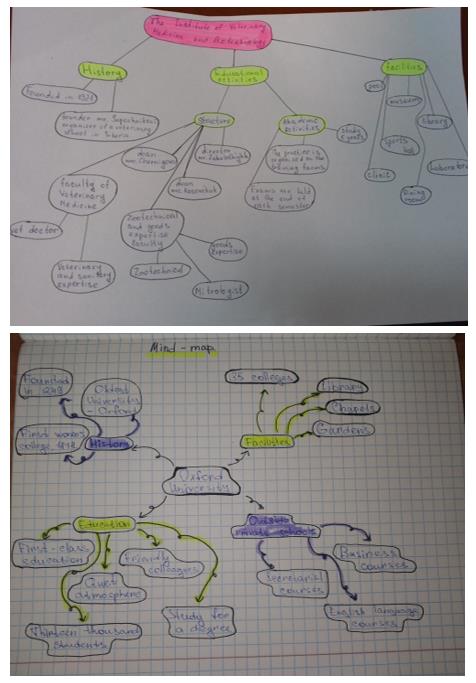
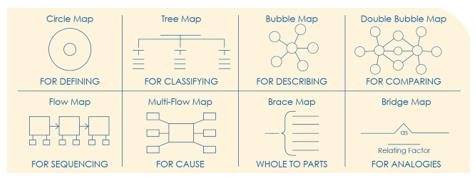
Visual matrix is another visual thinking tool developed by Kolesnik (2009). It can promote students’ creative visual thinking in many ways. It helps to generate ideas about the topic, establish relationships between images. Visual matrixes can be made by teachers or students, and they can be used with different teaching or learning purposes: students can be engaged in the discussion about a visual matrix; teachers can present a new topic or topical vocabulary with a visual matrix; students can drill new vocabulary and grammar patterns; or create stories, etc. There are examples of visual matrixes made by students as homework with further discussion about cultural differences in the ESP classroom (Figure 06).

Making collages is another visual thinking strategy which encourages creative expression and imaging thinking in students. A collage is an alternative to a poster or a visual matrix. It represents ideas in the visual form. Collages can be used as a communicative stimulus for group discussions, making stories or making speeches on the topic. Collages like other visual thinking tools generate enthusiasm and motivation for the language use, engage students with integrated visual and language content. Here are examples of students’ collages made for self-presentations in the ESP classroom (Figure 07).
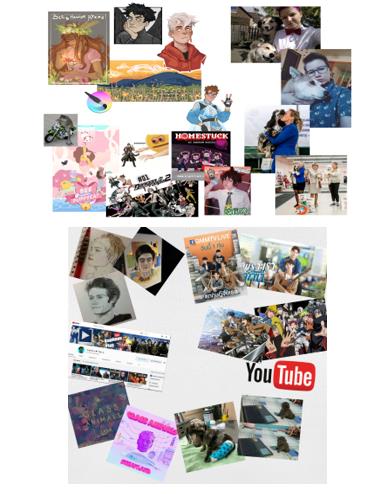
To sum up, the main educational elements such as learning objectives and outcomes, content and methodology have been described in the study with the special emphasis on VL integrated into ESP class. By employing the method of modeling, we attempt to conceptualize the integration of VL teaching in the ESP course (Figure 08). Modeling method helps to systematize the knowledge about structural elements of the ESP course and gives ways of more holistic description of integrative VL and communication skills teaching. Also, this method is used to represent the conceptualization of VL-oriented ESP course visually.
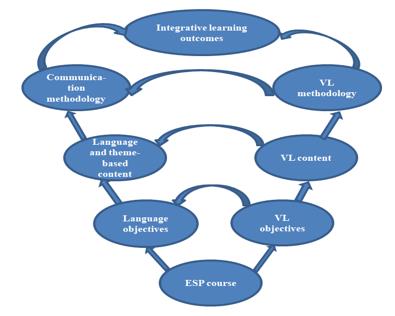
Conclusion
The study has discussed systemic characteristics of VL teaching integrated in the ESP course. The research has focused on the specificity of learning objectives, learning outcomes, content and methodology of a VL-oriented ESP course. Integrative learning objectives of the ESP course are defined as development VL and improvement of English communication skills in university students in profession-related contexts.
The problem of VL conceptualization has been addressed on the basis of Seels’s VL theory. A three-component VL model, including visual learning, visual communication and visual thinking, has been proposed in the study. We have defined the concept of VL as a combination of cognitive abilities to understand communication of visual messages, express ideas visually and think critically about visual messages. For assessing the progression of VL (learning outcomes) in students, the criterion-based scheme has been designed.
The ESP course content is integrative as it combines three basic contents: VL-related content, theme-based content and language content. Integrative content instruction has been designed on the basis of several visual education approaches: full-spectrum visual learning, active and performance-based learning, critical thinking and visual mapping approaches.
The methodology of the ESP course has been defined by the specific instructional strategies: “deep viewing” method, “reading circles” strategy, sketchnoting method, visual thinking tools. These strategies engage students in both visual literacy and communication practices in profession-related contexts. Moreover, they promote students’ creativity, critical thinking and open-mindedness.
As a result, an integrative model of VL teaching in the ESP course has been designed. It gives a more holistic description of integration of VL teaching in the ESP course.
References
Anderson, K., Robinson, E., Rhonda, S., & Brynteson, K. (2015). Teaching visual literacy: Pedagogy, design and implementation, tools, and techniques. Essentials of Teaching and Integrating Visual and Media Literacy (pp. 265-290). Springer. DOI:
Avgerinou, M. D., & Ericson, J. (1997). A review of the concept of visual literacy. British Journal of Educational Technology, 28(4), 280–291. DOI:
Avgerinou, M. D., & Pettersson, R. (2011). Toward a cohesive theory of visual literacy. Journal of Visual Literacy, 30(2), 1–19. DOI:
Bleed, R. (2005). Visual literacy in higher education. EDUCAUSE Learning Initiative Explorations, 1, 1–11.
Bowen, T. (2017). Assessing visual literacy: A case study of developing a rubric for identifying and applying criteria to undergraduate students learning. Teaching in Higher Education, 22(6), 705–719. DOI:
Brumberger, E., & Northcut, K. (2013). Meeting the challenge of teaching visual communication. In E. Brumberger & K. Northcut (Eds.), Designing texts: Teaching visual communication (pp. 1-7). Baywood Publishing.
Chalikandy, M. (2013). A comprehensive method for teaching English for Specific Purpose. Arabian World English Journal, 4(4), 310-322.
Debes, J. (1968). Some foundations for visual literacy. Audiovisual Instruction, 13, 961-964.
Gangwer, T. (2009). Visual impact, visual teaching. Corwin.
Goldstein, B. (2016). Visual literacy in English language teaching: Part of the Cambridge Papers in ELT series. Cambridge University.
Hartsell, T. (2015). Mapping concepts for learning. Essentials of teaching and integrating visual and media literacy (pp. 203-215). Springer. DOI:
Hattwig, D., Bussert, K., Medaille, A., & Burgess, J. (2013). Visual literacy standards in higher education: New opportunities for libraries and student learning. Libraries and the Academy, 13(1), 61–89. DOI:
Kędra, J. (2018). What does it mean to be visually literate? Examination of visual literacy definitions in a context of higher education. Journal of Visual Literacy, 37(2), 67-84.
Kolesnik, V. (2009). Visual matrix: flexible thinking tool. Retrieved on 16th of June 2021 from: https://kolesnik.ru/2009/visual-matrix/
Milosevic, D. (2017). Using video materials in English for technical sciences: a case study. New developments in ESP teaching and learning research (pp. 15-30). DOI:
Pailliotet, A. W. (1993). Understanding visual information through deep viewing. Visual Literacy in the Digital Age: Selected Readings from the Annual Conference of the International Visual Literacy Association (October 13-17, 1993). International Visual Literacy Association.
Poliakov, O. G. (2004). Aspects of specialism-oriented English language learning and teaching at tertiary school [Monograph]. Tambov University Press.
Rohde, M. (2013). The sketchnote handbook: The illustrated guide to visual note taking. Peachpit Press
Seels, B. A. (1994). Visual literacy: The definition problem. Visual literacy: A spectrum of visual learning (pp. 97-112). Educational Technology Publications.
Simbirtseva, N. А. (2013). Visual aspect of modern culture: the problem of visual literacy. Political linguistics, 4(46), 230-233.
Suryanto, S. (2014). How can visual literacy support English language teaching? Lingua, Journal Bahasa & Sastra, 15(1), 35-43
Copyright information

This work is licensed under a Creative Commons Attribution-NonCommercial-NoDerivatives 4.0 International License.
About this article
Publication Date
02 December 2021
Article Doi
eBook ISBN
978-1-80296-117-1
Publisher
European Publisher
Volume
118
Print ISBN (optional)
-
Edition Number
1st Edition
Pages
1-954
Subjects
Linguistics, cognitive linguistics, education technology, linguistic conceptology, translation
Cite this article as:
Kulamikhina, I., Kamysheva, E., & Samylova, O. (2021). Integrating Visual Literacy Teaching Into The English For Specific Purposes Course. In O. Kolmakova, O. Boginskaya, & S. Grichin (Eds.), Language and Technology in the Interdisciplinary Paradigm, vol 118. European Proceedings of Social and Behavioural Sciences (pp. 689-702). European Publisher. https://doi.org/10.15405/epsbs.2021.12.84

